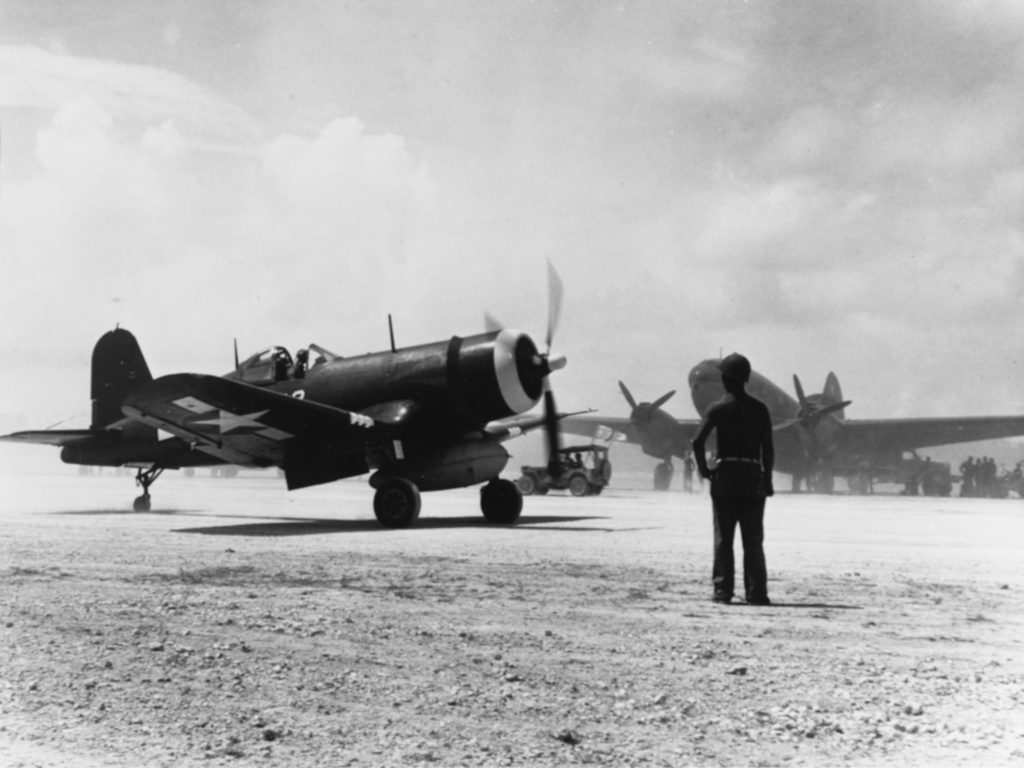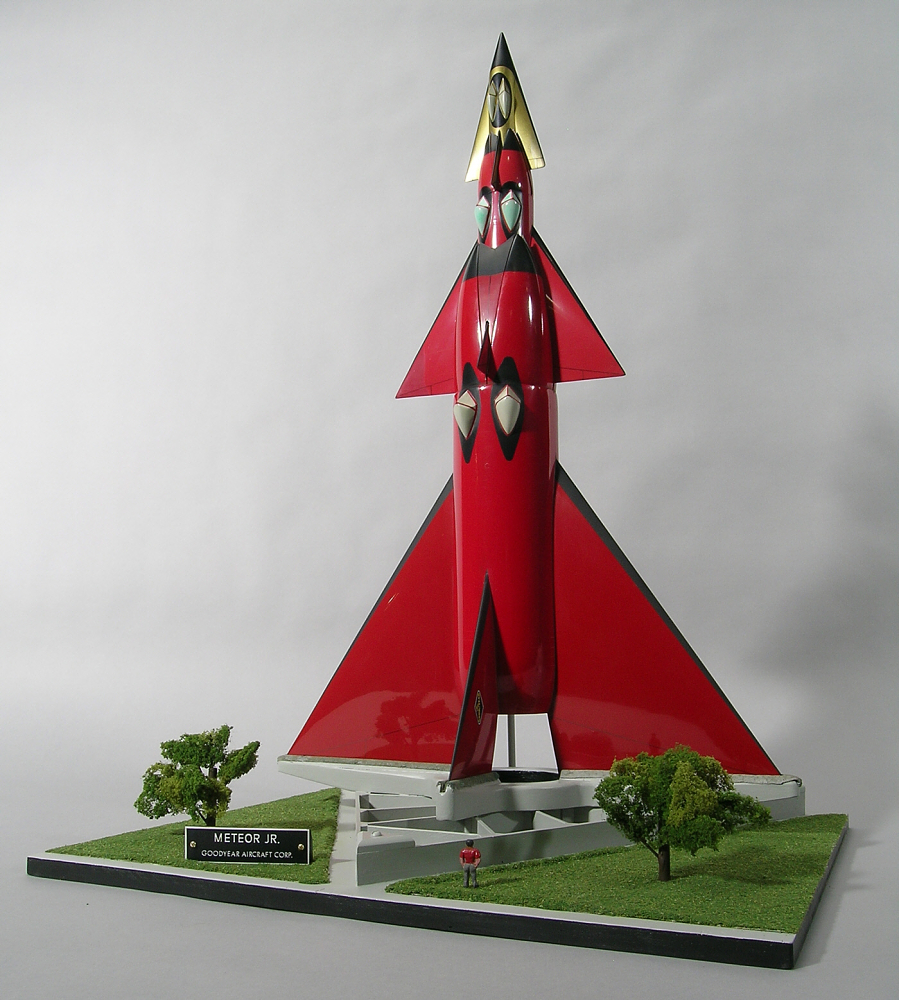
Yes, that Goodyear. Or more precisely, a division of Goodyear, at the time called the Goodyear Aircraft Company—the same folks who were designing, building, and maintaining Goodyear’s iconic blimps and rigid airships.
As so many other companies did during World War II, Goodyear shifted its attention to the war effort. And while there was an obvious need for Goodyear’s core business to keep cranking out tires and other vital rubber products, the Goodyear Aircraft Company turned much of its focus on making parts for fixed-wing airplanes.
And perhaps its most important job was assisting in the production of the Corsair—a dual-role fighter-bomber that is regarded as one of the most important aircraft of World War II.

Chance Vought & Goodyear: A Vital Manufacturing Alliance
First off, it’s important to realize that the Corsair was actually designed and developed by the Chance Vought aircraft company.
But much like Packard did with the Rolls Royce Merlin Engine, Goodyear pivoted its aviation manufacturing capabilities and began producing Corsairs under license from Vought.
That’s because, given its versatility and performance, the Corsair was a very popular fighter plane in the U.S. arsenal. So much so, that the Chance Vought company could not meet the production demand for the aircraft, which meant Goodyear was tasked with stepping up to the plate.
And it stepped up big time—in fact, Goodyear accounted for about one-third of total Corsair production during World War II.
While the planes were similar, Vought-produced Corsairs were designated F4U and Goodyear-made Corsairs were designated FG, for Fighter Goodyear. A third company, Brewster Aeronautical Corporation, also built Corsairs under license with the designation F3A.

Chance Vought F4U Corsair Development
As is often the case, the Corsair was born out of a set of requirements for a proposed new aircraft for the United States Navy.
In addition to being fast, the new plane needed to have a service range of 1,000 miles, carry up to four guns, and include provisions for bombs to be carried under each wing. The request was made in February of 1938 and by May of 1940, a Corsair prototype was in the air.
The prototype, dubbed the XF4U-1, was propelled by a Pratt & Whitney 18-cylinder “Double Wasp” radial engine initially making over 1,800 horsepower. After a few months of refinement, the XF4U-1 became the first single-engine U.S. fighter plane to exceed 400 mph.
Further design improvements and armament modifications proceeded until the Navy, now satisfied with the aircraft’s performance, placed an order for over 500 Corsairs. And the first “production” Corsair took to the skies in 1942.

Perhaps the Corsair’s most defining characteristic is its distinctive gull wings—a necessary design element that allowed its landing gear to be both strong and short, while still providing enough ground clearance for the plane’s large propeller. Given its anticipated role as a carrier-based aircraft, the Corsair also has the ability to fold its wings up vertically to save space on a crowded deck.

Corsair Combat Effectiveness
While initially expected to fill carrier-based roles, the Navy gradually realized that the new Grumman F6F Hellcat was better suited to those air-to-air attack and defense operations. Yet when used from land-based airstrips, United States Navy and Marine Corps pilots found the Corsair to be an extremely capable aircraft in both air-to-air and air-to-ground combat support. Corsairs were also used as escorts for heavy bombers like the B-24 Liberator, as the Allied forces moved across the Pacific.

It could outperform most Japanese aircraft and was a vital component of several key Allied victories that helped turn the tide of the War in the Pacific.
The Corsair, in its various configurations, is regarded as one of the best Allied fighter aircraft of World War II. And thanks to its versatility, it continued to see action long after the war ended, fighting in the Korean War and serving in other militaries up through the 1960s.
Yet if World War II hadn’t ended in 1945, Goodyear had some interesting plans up its sleeve…
The Goodyear F2G “Super” Corsair

Remember that 1,800+ horsepower Pratt & Whitney engine? The one that made the Corsair the fastest single-engine fighter aircraft in the United States at the time?
Well, in the years following that engine’s introduction, the Pratt & Whitney folks went back and developed a new 3,000 horsepower, 28-cylinder R-4360 engine. It was big. It was powerful. And it needed a home.
So Goodyear engineers took the FG Corsair airframe and modified it to accommodate the new monster motor. Dubbed the “F2G Super Corsair,” prototype models began testing in 1944. Though the design showed promise, the United States sensed that the end of the war was approaching, and cancelled the contract on the Super Corsair.
Still, despite the imminent arrival of the jet age, 10 of these Super Corsairs were completed and two remain airworthy to this day.
Goodyear Aerospace: Blimps & Beyond….
After the war, the Goodyear Aircraft Company transitioned into the Goodyear Aerospace Corporation where it worked on a variety of projects—including a proposed reusable three-stage rocket system that predicted the Space Shuttle and today’s reusable rocket platforms.
In 1987, Goodyear restructured and the Aerospace wing was sold to the Loral Corp., which was soon acquired by Lockheed Martin in 1993.

Want More Corsair?
We found this great mini-documentary from Goodyear’s Aviation Tire division that highlights the Corsair and the Super Corsair.
In a hurry? Skip to the around the seven minute mark and you’ll hear the sound of the 3,000 horses trapped inside the F2G’s airframe. Check it out:

Can anyone provide data on an aircraft built by Goodyear during WWII that a worker on same said she thought it was named a Teica? It was a small two passenger aircraft manufactured in Canton, Ohio. I think her work on same would have been around 1944, and she worked the cockpit area on upholstery and other things. She was later moved to bookkeeping, that was her job with another company when she went help on the war effort, that she worked when the war ended.
Goodyear did not stretch the fuselage, they built a shorter engine mount to accomodate the 4360 .Then they built a new cowling to fit the carburator intake and new engine. They then cut down the top of the fuselage from frame 186 towards the tail to give better visability. So please dont say the f2g is a lengthened version of the fg-1.